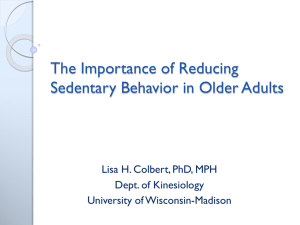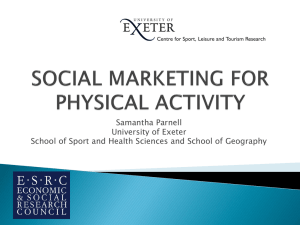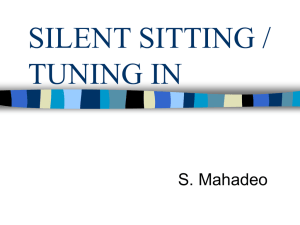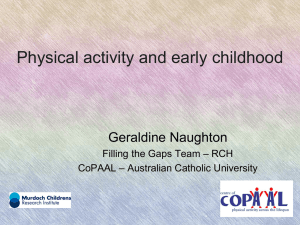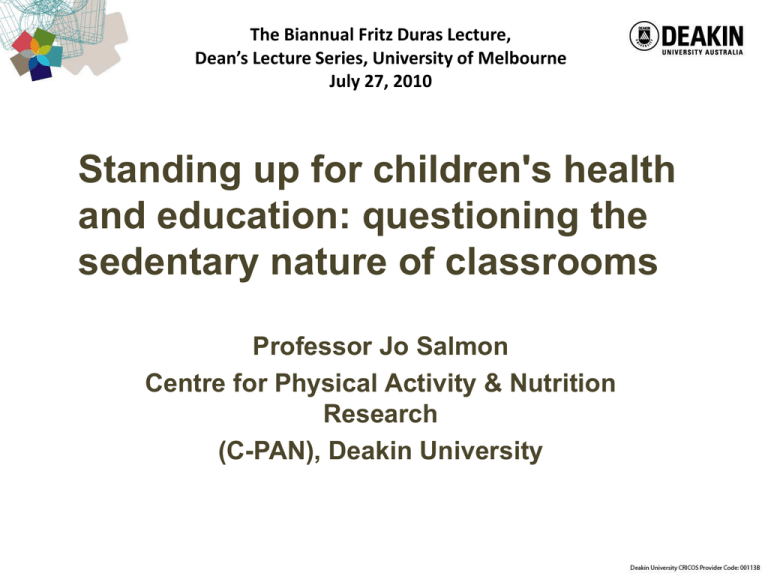
The Biannual Fritz Duras Lecture,
Dean’s Lecture Series, University of Melbourne
July 27, 2010
Standing up for children's health
and education: questioning the
sedentary nature of classrooms
Professor Jo Salmon
Centre for Physical Activity & Nutrition
Research
(C-PAN), Deakin University
Overview
• Children’s health in Australia
• Sedentary behaviour (or time spent sitting):
an alternative perspective
• Role of schools & teachers in reducing
children’s sitting time
• As the pioneer of physical education in
Australia & a former physician,
Professor Fritz Duras (1896 – 1965) would
have some interesting thoughts about
current role of schools & education in
children’s health in Australia
% Australian children overweight/obese, 2007
25
20
15
Overweight
%
Obesity
10
5
0
Boys
2–3y
Girls
4–8 y
9–13 y
14–16y
2–3y
4–8y
9–13 y
14–16y
(CSIRO, 2008)
Childhood overweight/obesity: Worldwide
trends & 2010 projections
50
45
40
35
30
%
Americas (1988-2002)
Eastern Med (1992-2001)
25
Europe (1992-2003)
South East Asia (1997-2002)
20
West Pacific (1993-2000)
15
10
5
0
Most recent Projected Most recent Projected Most recent Projected Most recent Projected Most recent Projected
2010
2010
2010
2010
2010
Wang & Lobstein IJPO 2006
Trends in overweight/obesity among children in
Australia: 1985-2005
Olds et al IJO 2010
Odds ratios for obesity in young adulthood
Whitaker et al, 1997
Obesity trends & Type 2 diabetes among
children in Japan
Type 2 diabetes
7.0
6.0
5.0
4.0
8.0
3.0
7.0
Obesity
2.0
6.0
5.0
1.0
1975
Kitagawa T et al. Clin Pediatr 1998
1980
1985
1995
1995
Prevalence of obesity (%)
Type 2 diabetes incidence / 100 000
population per year
8.0
Role of energy balance behaviours
30%
Genetics
15%
Environ
-ment
Social
Health
Health behaviours
present the
“greatest single
domain of
5%
influence” on
health in the
population
(McGinnis et al., Health
Affairs, 2002)
Medical
care
10%
Health
Behavior
40%
Physical activity
Energy dense
drinks & foods
Childhood
Obesity &
metabolic
health
Genetics
Sedentary
behaviour
Sedentary behaviour (or time spent
sitting): an alternative perspective
word sedentary derives from the Latin verb
sedere, meaning to sit
a distinct group of sitting/lying behaviours that
involve low energy expenditure to perform
(≤1.8 METs)
EG: schoolwork, reading, watching TV,
computer use, car travel
Changes in children’s discretionary
and non-discretionary time
Change in electronic entertainment
media environment
Median mins/day TV viewing 1949-2000
Marshall et al, 2006
Change in homework time 1981-1997, US
4:19
3:50
3:21
Hrs/week
2:52
3-5 yrs
2:24
6-8 yrs
9-12 yrs
1:55
All ages
1:26
0:57
0:28
0:00
1981
1997
1981
Hofferth & Sandberg, 2000
1997
1981
1997
1981
1997
Illustration of SB based on muscular activity
4 STEPS
GETTING OUT
OF A CHAIR
SITTING
Hamilton et al Diabetes 2007
STANDING
Screen-time & children’s health
(Rey-López et al, 2008)
Objectively-assessed sedentary time & health
(Sardinha et al Diab Care 2008)
HOMA-IR by stratified quartiles of time spent sedentary
(Actigraph), p<0.05 between Q1 & Q4 (n=147)
Adj for sex, birth weight, pubertal status, fat mass
Patterns of sedentary time
6000
Mod-to-Vigorous PA
5000
3000
2000
Light Intensity
1000
PM
11
:0
0
10
:0
0
PM
M
P
M
00
9:
00
P
M
8:
7:
00
P
M
P
M
00
6:
00
P
M
5:
00
P
M
4:
00
P
M
3:
00
P
M
2:
00
P
PM
1:
:0
0
AM
12
11
:0
0
AM
M
:0
0
10
00
A
M
9:
00
A
M
8:
00
A
M
7:
6:
00
A
M
A
M
00
5:
00
A
M
4:
3:
00
A
M
A
00
A
2:
00
1:
:0
0
AM
M
0
12
ACTIVITY
4000
TIME
Sedentary (<100 counts per minute)
Interruptions or breaks
in sustained periods
being sedentary
Acknowledgement: Genevieve Healy, UQ
Mean accumulated time spent sedentary
across school day
(Salmon, Healy, Hume, Ridley, Timperio, Dunstan, Owen, Crawford)
174±46 mins/day (48% of time)
48%
51%
(p<0.001)
mins
SB & light PA : r = -0.78
SB & MVPA: r = -0.55
N=2,452 participants
Mean number sedentary
breaks in school day
33±6 breaks/day
10-12 yo = 34 breaks/day
5-6 yo = 31 breaks/day (p<0.001)
Breaks & light PA : r = 0.37
Breaks & MVPA: r = -0.06
Associations with BMI z-score
Total sedentary time*
5-6 yo: r = -0.04 (ns)
10-12 yo: r = 0.01 (ns)
Sedentary breaks*
5-6 yo: r = -0.12 (p=0.001)
10-12 yo: r = -0.11 (p<0.001)
*partial correlations adj for light & MVPA
Sedentary breaks/day & weight status
p=0.04
p=0.01
AOR (light, mvpa) for each additional break 5% less likely ov/ob
Hypothetical1 EE over a 12-hour day for 2 children both meeting PA recommendations
8
7
6
5
4
couch-potato
non C-P
3
2
1
0
1PA
defined > 3 METs (green line)
SB defined as 1.0-1.8 METs (shaded area)
How can we intervene to reduce
children’s discretionary & nondiscretionary sedentary time?
• What are the potential health & educational
benefits?
“One boy’s day” ( Ackn: Barker & Wright, 1951)
Role of schools & teachers in
reducing children’s sitting time & on
educational outcomes
Strategies to reduce children’s TV viewing
Study settings
Strategies
Outcome
School-based
Educational
+++++++ -
Family-based
Educational
++ 000 ~
Reinforcement/contingency
++
TV allowance unit
++++ ~
Computer software
+
Active electronic games
+
Educational
+00
TV allowance unit
0
Statewide campaign
+
Primary-care
Community/population
Lanningham-Foster et al. Changing the school
environment to increase children’s PA Obesity 2008
3 conditions:
Traditional school
Activity permissive school
Standing classroom
Mahar et al Effects of a classroom-based program
on physical activity and on-task behavior. MSSE 2006
Grieco et al. Physically active academic lessons, time
on task & BMI. MSSE 2009.
Mean % of time on task for the inactive control condition (left) & the active
condition (right) for normal weight, at risk & overweight children (n=97)
Liu et al Evaluation of a classroom-based physical
activity promoting programme. Obes Rev 2008
10-min activity break every day during school
class times
5
4.5
4.4
4
3.5
Hrs/day
3
2.5
3.3
2.9
Intervention
2.8
Control
2
1.5
1
0.5
0
Baseline
Post
Baseline
Post
Erwin et al Promoting children’s health through
physically active math classes. Health Promot Practice
Step
Steprate
rate(mean
(mean±±SE)
SE)during
duringbaseline
baselineand
andphysical
physicalactivity
activity(PA)
(PA)integration
integrationmath
school
classes
days
Reed et al. Impact of active lessons on fluid
intelligence & academic performance. JPAH 2010
• PA integrated into core curricula (~30
mins/day, 3 days/wk, Jan-April 2008) n=155,
9yr olds
• Used non-invasive fluid intelligence cognitive
measures & State-mandated academic
achievement tests
• Children in active lessons performed better
on Fluid Intelligence Test & on the Social
Studies academic achievement test
Summary
• Active lessons can:
– lead to increased PA across the school day
– lead to increased time on task/concentration
– lead to better fluid intelligence scores
• What about reducing overall sitting time in
class?
• What about increasing number of
interruptions/breaks to sitting in class?
• Not just school time important, family setting
also key focus
Transform-Us! intervention for
reducing sedentary behaviour &
promoting physical activity
Salmon1, Hume1, Arundell1*, Brown1*, Hesketh1, Daly2, Dunstan3, Ball1,
Crawford1, Pearson1, Cerin4, Moodie1, Bagley1*, Chin A Paw5
1Deakin
Uni; 2Uni Melb; 3Baker/IDI; 4Hong Kong Uni; 5Vumc
Netherlands; *PhD students
Aims
Examine efficacy of 18-mth intervention
targeting reductions in SB & increases in PA
alone & in combination among 8-9 yr olds
compared with current practice
Examine health outcomes, mediators &
perform economic evaluation
Participants & design
20 primary schools (within 50km
Melbourne), ~600 children aged 8-9 yrs
All year 3 students in intervention schools
will receive the intervention, those with
active consent will participate in assessment
4 groups:
SB-I reducing sedentary (sitting) time at school & home
PA-I increasing PA during school breaks & outside of
school hours
SB+PA-I combination of above
C usual curriculum
Intervention strategies
SB-I
School environment
Curriculum
component
PA-I
SB+PA-I
18 key learning messages
18 key learning messages
18 key learning messages
-
Class strategies
Standing lessons (1/day)
Active 2- min breaks after
30-min class time
-
Standing lessons
Active breaks
-
Physical
environment
-
Provision of sporting
equipment and signage
Provision of sporting
equipment and signage
Reduce sitting time while
completing h/w
Tips for reducing sitting
time at home
h/w tasks incorporate PA
Tips for increasing PA at
home
h/w tasks incorporate PA
and reductions in sitting
time
Tips to reduce sitting time
and promote PA at home
Home environment
Homework (h/w)
tasks
Newsletters
SB-I: reduce sitting in class
Delivery of 9 key messages/yr
Teachers will modify the delivery of one class
lesson per day (30-45 minutes) so children
complete the lesson standing (eg, classroom
activity stations)
On average, this will result in 150-mins
less sitting per week
SB-I: interrupt sitting in class
Interrupt 90-120 min classroom teaching blocks
every 30-mins with 2-min guided light-intensity
activity break (eg, standing passing ball around
while recalling key learning outcomes from
current lesson)
Should equate to ~6 mins interrupted sitting time
every 2 hrs (~ 60-minutes less sitting time per
week)
SB-I: family setting
8 postcards/yr to parents with tips & key
messages for reducing SB at home (eg,
effective use of rules)
Homework assignments (eg, switch off TV for
weekend)
TV allowance unit
PA-I: environmental cues & prompts
access to PA equipment (recess & lunch
breaks)
Line markings
Signage
DID YOU KNOW IT
TAKES 30 HOPS TO
GET TO THE
LIBRARY FROM
HERE??
PA-I: key messages & active
homework
Delivery of 9 key messages/yr
8 postcards/yr to parents with tips & key
messages for encouraging child’s PA at home
& in neighbourhood (eg, Kinect Australia
website and free Infoline)
Active homework (eg, go for a walk in your
street with mum or dad & count the number of
letterboxes)
Yamax Digiwalker pedometer
Pilot study
2009, pilot study to test strategies to reduce
children’s sitting time in class & at home
n=124 children, n=6 teachers, n=28 parents
Teachers delivered 2 standing lessons &
interrupted sitting over 2-wks & gave 2
homework tasks designed to reduce sitting
time & increase PA
Standing lessons
Talking easels
Interrupted sitting
class time
Stand & Discuss
Standing homework
Walk around Australia
Interrupted sitting
homework
Stand & spell/rise & read
Sedentary time in class (mins/day)*
*Actigraph accelerometer (sed time <100cpm)
Percent of time in sedentary, LPA, MVPA Weeks
1 & 3 during classtime
Week 1
Week 3
Children’s perceptions
“When you’re standing, you might fiddle with
your legs, and you don’t hear what the
teachers say” (Yr 4 child)
“I would like to do more standing lessons
because if you sit down for too long you get
all ‘blah’ and then you don’t focus as much”
(Yr 4 child)
Teachers’ perceptions
“I try to get them …to move …around a bit
and stuff, but to do stuff at the standing
lesson …it was great fun, it was new for
them, so they really enjoyed it.” (Yr 4 teacher)
“they (parents) loved the idea behind it, of
getting kids …moving around in class a bit
more” (Yr 4 teacher)
Study progress
July 2010, have parental consent for 589
children from 20 primary schools in
Melbourne to participate in assessment
components of intervention & 353 (60%) of
these children have undergone a fasting
blood sample test
PD with teachers commencing this week!
Reflection & future directions
Can have strong synergies between physical
activity, health & education
Active lessons NOT intended to replace PE!!
Standing/active classrooms have previously
been trialled (eg, Liu et al 2008; Lanningham-Foster et al
2008; Grieco et al 2009) effects on reduced sitting time
& health are unknown
Interruptions to sustained periods of sitting at
school & home untested
Focus on promoting PA, reducing SB
or both?
Reductions in SB likely to result in increased
light-intensity PA (unknown health implications)
Targeting discretionary & non-discretionary time
more effective than targeting only one?
Organisational change & pedagogy in schools
Ideal child’s day would include much less sitting
than is currently the case & would embed PA
throughout the day
One boy’s day –Take 2!
Final word from Prof Duras:
• “So, rightly understood, the physician
becomes somewhat of an educationist, and
the teacher tries to treat his [or her] pupil
with the understanding, the love and the
patience of a good physician”
Acknowledgements
Starring: Jack, Henry & Helen Brown & Leo the
Golden Retriever as themselves!
Cinematography: Peter Brown
Funding: National Health & Medical Research
Council, National Heart Foundation of
Australia and sanofi-aventis, Mazda
Foundation
The Behavioural Epidemiology Team
David Dunstan, Neville
Owen, Gen Healy &
team
In memory: Leigh Brown
• Senior Lecturer, Medical Sciences, RMIT
• Co-ordinated courses in the Bachelor of Applied
Science (Physical Education) & Bachelor of
Applied Science (Human Movement) degrees
• Long history working with Sydney Swans FC

